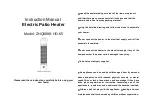
27
It is recommended that the water heater storage tank be drained
and
fl
ushed every 6 months to reduce sediment buildup. The
water heater should be drained if being shut down during freezing
temperatures. See Features And Components in this manual for
the location of the water heater components described below.
DRAINING AND FLUSHING
Burn harzard.
Hot water discharge.
Keep hands clear of drain
valve discharge.
TO DRAIN THE WATER HEATER STORAGE TANK:
Turn off the electrical supply to the water heater.
1.
Turn off the gas supply at the Main Gas Shutoff Valve if
2.
the water heater is going to be shut down for an extended
period.
Ensure the cold water inlet valve is open.
3.
Open a nearby hot water faucet and let the water run until
4.
the water is no longer hot.
Close the cold water inlet valve to the water heater.
5.
Connect a hose to the water heater drain valve and terminate
6.
it to an adequate drain.
Open the water heater drain valve and allow all the water to
7.
drain from the storage tank.
Close the water heater drain valve when all water in the
8.
storage tank has drained.
Close the hot water faucet opened in Step 4.
9.
If the water heater is going to be shut down for an extended
10.
period, the drain valve should be left open.
TO FLUSH THE WATER HEATER STORAGE TANK
:
Turn off the electrical supply to the water heater.
11.
Ensure the cold water inlet valve is open.
12.
Open a nearby hot water faucet and let the water run until
13.
the water is no longer hot. Then close the hot water faucet.
Connect a hose to the drain valve and terminate it to an
14.
adequate drain.
Ensure the drain hose is secured before and during the
15.
entire
fl
ushing procedure. Flushing is performed with system
water pressure applied to the water heater.
Open the water heater drain valve to
fl
ush the storage tank.
16.
Flush the water heater storage tank to remove sediment and
17.
allow the water to
fl
ow until it runs clean.
Close the water heater drain valve when
fl
ushing is
18.
completed.
Remove the drain hose.
19.
Fill the water heater - see Filling The Water Heater in this
20.
manual.
Turn on the electrical supply to place the water heater back
21.
in operation.
Allow the water heater to complete several heating cycles to
22.
ensure it is operating properly.
Expansion on page 12. The Temperature-Pressure Relief Valve
is not intended for the constant relief of thermal expansion.
Temperature-Pressure Relief Valve leakage due to pressure
build up in a closed system that does not have a thermal
expansion tank installed is not covered under the limited
warranty. Thermal expansion tanks must be installed on all
closed water systems.
DO NOT PLUG THE TEMPERATURE-PRESSURE RELIEF
VALVE OPENING. THIS CAN CAUSE PROPERTY DAMAGE,
SERIOUS INJURY OR DEATH.
Explosion Hazard
Temperature-Pressure Relief Valve
must comply with ANSI Z21.22-
CSA 4.4 and ASME code.
Properly sized temperature-
pressure relief valve must be
installed in opening provided.
Can result in overheating and
excessive tank pressure.
Can cause serious injury or death.
HOT WATER ODOR
On occasion, hot water may develop a strong odor. If this occurs
drain the heater completely,
fl
ush thoroughly, and re
fi
ll. If the
problem persists, chlorination of the heater and replacement of
the factory installed magnesium anodes with aluminum anodes
may correct the condition.
Occasionally water softener companies recommend removal of
heater anodes for odor reasons.
Unauthorized removal of the anode(s) will void the warranty. For
further information contact your dealer.
ANODE ROD INSPECTION
The heater tank is equipped with anode rods to provide corrosion
control. At least once a year the anode rods should be checked
to determine if replacement is necessary. Initially the anode rods
are approximately 7/8” in diameter with a 1/8” diameter steel core
wire running down the center of the anode material. THE ANODES
SHOULD BE REPLACED when the 1/8” diameter core wire is
visible as this means that the anode material has been expended
in the control of corrosion.
For models with top inlet and outlet, it is recommended that, before
removing the inner cover for cleaning, inspection or removal of
inner parts, you obtain two new nipple collars, part no. 74060.
The nipple collars on the heater will usually be damaged when
removed. New pipe collars will insure that the seal is such as to
prevent leakage of
fl
ue products when properly installed.
NOTE:
Anode rod inspection may need to be made more
frequently in areas subject to acid rain that obtains their water
supply from surface water as the low pH will accelerate anode
activity.
CAUTION:
Close cold water inlet valve serving heater and open
nearby hot water faucet to relieve the pressure in the heater before
attempting to remove anode(s) for inspection.
















































